Joseph Hobson
Joseph Hobson (1834–1917) was a Canadian land surveyor, civil engineer, and railway design engineer. He was the resident engineer during the construction of the International Railway Bridge and designed the first St. Clair railway tunnel. This was the first underwater railway tunnel between Canada and the USA and, when it opened in 1891, the first undersea tunnel linking two distinct countries and the longest undersea tunnel then constructed.
Joseph Hobson | |
|---|---|
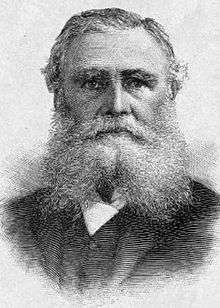 | |
| Born | 1834 |
| Died | 1917 (aged 82–83) |
| Nationality | Canadian |
| Occupation | Land surveyor, civil engineer |
Early life and education
Hobson was born in 1834 in Guelph Township in Wellington County, Ontario.[1] He had a brother, John, who was born in 1835.[2] Hobson's parents were Joseph and Margaret Hobson.[2]
Hobson attended log schoolhouses in Guelph for his primary schooling. He then moved to Toronto and was there for seven years. He apprenticed with John Tully as a land surveyor.[2] During this time he did layout plans for the Ontario towns of Kitchener and Guelph. Later he apprenticed under C. Schofield and he passed his final exam in 1855 for a provincial land surveyor.[1]
Engineering career
Hobson in 1856 joined the firm of Gzowski and McPherson in Toronto.[3] He returned to Kitchener in 1858 from Toronto to work for the county of Waterloo as their engineer on a part-time basis. Besides being the county engineer he also did private surveying. One of his contracts was the surveying of the township of Bidwell on Manitoulin Island.[4]
Hobson was later an assistant engineer on the construction of the Grand Trunk Railway from St. Marys to Sarnia. He was also engaged in railway surveys in Nova Scotia and also in the United States. Hobson lived in Guelph from the mid 1860s to the mid 1870s. From the summer of 1869 to the spring of 1870 he was an engineer to George Lowe Reid, chief engineer of the Great Western Railway. He assisted in the building of the Wellington, Grey and Bruce Railway from Guelph to Southampton.[5]
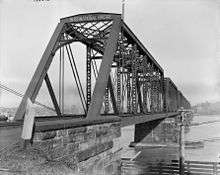
Construction of the International Railway Bridge, across the Niagara River between Fort Erie, Ontario and Buffalo, New York, was contracted out in 1870 for a cost of over $1 million. The bridge was about a half mile long. The engineer-in-chief was E.P. Hannaford. Hobson was the resident engineer and lived onsite. When this project was done at the end of 1873 Hobson was promoted to chief assistant engineer of the Great Western Railway and further promoted to chief engineer in 1875.[6] He moved to Hamilton, then. In 1882 he became chief engineer of the Grand Trunk Railway west of Toronto.[1]
Hobson was appointed in 1886 to design and build the St. Clair Tunnel between Sarnia in Ontario and Port Huron, Michigan. The tunnel was constructed within a year and the first trains ran through in the later part of 1891. It was then the first undersea tunnel linking two distinct countries, and the longest then constructed, at 6,025 feet portal to portal.[7] Total length of the tunnel counting the approaches was 11,500 feet. The cost was over $2.5 million. After this project Hobson became chief engineer for the entire Grand Trunk Railway in 1896.[8] The tunnel was converted to run electric trains in 1908.[7]
- widths="180px"
 St Clair 1890 tunnel entrance
St Clair 1890 tunnel entrance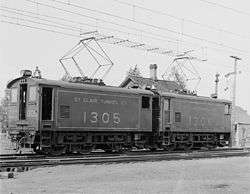 Electric engine locomotive, 1500 h.p.
Electric engine locomotive, 1500 h.p. Line of excavation
Line of excavation St Clair tunnel engineering drawing
St Clair tunnel engineering drawing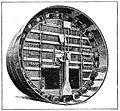 Shield in St Clair tunnel
Shield in St Clair tunnel Interior of St Clair tunnel
Interior of St Clair tunnel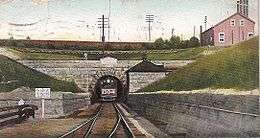 St Clair River Tunnel in 1907
St Clair River Tunnel in 1907 St Clair tunnel train
St Clair tunnel train
| Wikimedia Commons has media related to St. Clair River Tunnel. |
Retirement and death
Hobson retired from the railway industry in 1907. He was a railway consultant until his death in 1917 when he was 84 years old.[2]
Societies
Hobson was a member of the Canadian and American Societies of Civil Engineers and a member of the Institution of Civil Engineers of London, England. He also was a member in the Caledon Mountain Trout Club.[2]
Family
Hobson married Elizabeth Laidlaw of Guelph in 1856. They had two sons and four daughters.[2]
References
- Chilton 1918, p. 236.
- Irwin, Ross W. (2009). "Joseph Hobson (1834–1917)". Contributions to Professional Engineers. Association of Professional Engineers of Ontario. Retrieved October 17, 2015.
- Ball 1988, p. 24.
- "Joseph Hobson" (PDF). Association of Ontario Land Surveyors. 2015. Retrieved October 17, 2015.
- Toronto 2005, p. 480.
- Joseph Hobson, chief engineer of the St Clair tunnel – Opening of the St Clair River Tunnel, XXXV, no.1815, Harper's Weekly, October 3, 1891, pp. 758–760
- Kane 1997, p. 232.
- Middleton 2007, p. 526.
Sources
- Ball, Norman R. (1988). Mind, heart, and vision: professional engineering in Canada, 1887 to 1987. National Museum of Science and Technology, National Museums of Canada, in cooperation with the Engineering Centennial Board. ISBN 978-0-660-12000-3.CS1 maint: ref=harv (link)
- Chilton (1918). Iron Age. Chilton Company.CS1 maint: ref=harv (link)
- Kane, Joseph Nathan (1997). Famous First Facts, Fifth Edition. The H. W. Wilson Company. ISBN 0-8242-0930-3.
The first underwater railroad tunnel to a foreign country was the St. Clair Railway tunnel between Port Huron, MI, and Sarnia, Ontario, Canada, which was opened for freight traffic on September 19, 1891, and for passenger traffic on December 7. The tunnel was designed and built under the supervision of Joseph Hobson, chief engineer of the Grand Trunk Railway (later the Canadian National Railways), at a cost of $2.7 million. Its length from portal to portal was 6,025 feet. The tunnel was equipped with electricity on May 17, 1908.
CS1 maint: ref=harv (link) - Middleton, William D. (2007). Encyclopedia of North American Railroads. Indiana University Press. ISBN 978-0-253-34916-3.CS1 maint: ref=harv (link)
- Toronto (2005). Dictionary of Canadian Biography. University of Toronto Press. ISBN 978-0-8020-9087-4.CS1 maint: ref=harv (link)